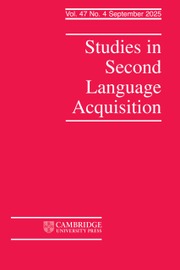Article contents
TRANSITIVITY ALTERNATIONS AND SEQUENCE LEARNING: INSIGHTS FROM L2 SPANISH PRODUCTION DATA
Published online by Cambridge University Press: 09 August 2006
Abstract
This article examines alternating verbs (such as quemar(se) “to burn”) in second language (L2) Spanish by considering the learnability problem from a sequence learning perspective (N. Ellis, 1996, 2002). In Spanish, verbs of the alternating class are obligatorily marked with the clitic se in their intransitive form. Errors of omission among English-speaking learners, who transfer zero-derived morphology from their native language, have been previously documented (Montrul, 2000). This study also examines a different kind of error—overgeneralization of se to transitive event scenes—that is hypothesized to result from chunking se with particular lexical items. The results of a picture description task reveal that learners frequently make this type of overgeneralization error, but that they are able to recover from it at more advanced levels of proficiency. These findings suggest that the acquisition of L2 morphosyntax is shaped by learners' familiarity with individual lexical items and the sequences in which they tend to appear.This study forms part of my dissertation research and was presented at AAAL in Portland, Oregon, in May 2004. I acknowledge the generous support of the University of California, Davis and the Humanities Research Grant that allowed me to conduct this research. I wish to thank Robert Blake for his guidance during the data collection phase of the project, Susan Gass and Charlene Polio for their helpful feedback on earlier drafts of this article, and Lourdes Sánchez González for helping me collect the native-speaker data. The comments and suggestions of three anonymous SSLA reviewers were also tremendously useful. All remaining errors are my own.%Address correspondence to Eve Zyzik, Department of Spanish and Portuguese, Michigan State University, 334 Old Horticulture Building, East Lansing, MI 48824; e-mail: zyzik@msu.edu.
Information
- Type
- Research Article
- Information
- Copyright
- © 2006 Cambridge University Press
References
REFERENCES
- 17
- Cited by

